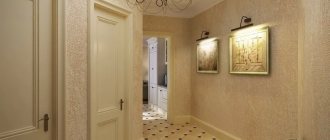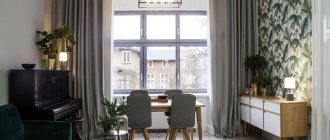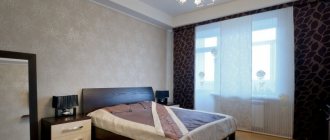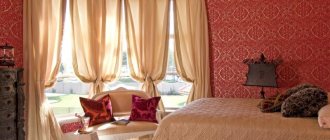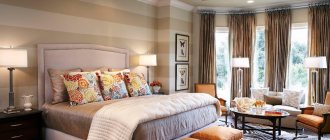It's no secret that a corridor is not only a connecting passage between rooms, but also a full-fledged space, just like a bedroom or living room in your apartment. That is why you should not neglect the high-quality design of the corridor, which requires compliance with the same rules as in the case of other rooms. One of the important aspects that many people prefer not to pay attention to is the choice of color in the interior of the corridor. Proper use of a color palette allows you to control the space and depth of the room, which is very important, especially if your corridor does not have enough square meters.
So let's look at all the possible color solutions, one way or another used in the design of the corridor. It is very important not only to choose a beautiful and aesthetic option that matches the overall interior of the apartment, but also to set a certain atmosphere, because the entrance hall and corridor are the places where your apartment begins, and it is they who should set the tone for all subsequent design.
General design of the corridor
When creating a good and harmonious interior, it is very important to pay special attention to the color scheme used. After all, the very mood that a person will receive when entering your apartment depends on the choice of color. First of all, the choice of color depends on several parameters:
- Room style. Not every style allows the free use of colors. An ideal example of this would be a classic style, in which bright and acidic colors would simply be out of place.
- Selected finishing materials. There is also a direct relationship here, as in the previous case. If you are decorating your corridor with natural wood, then it will simply be illogical to use purple. However, if panels are used, the color gamut will be much wider.
- Size of the room. Not all corridors would be wise to use dark shades. They visually narrow the room, which in the case of small corridors will be a rather negative factor.
Using these three rules, you can choose the perfect color combination for your hallway, which will create the necessary mood in the room where your home begins.
The choice of color deserves special attention if you have a studio apartment. In such rooms there is only an entrance hall, which most often smoothly transitions into the room itself.
Step-by-step design of the corridor
A harmonious choice of color in the corridor should contain not only a selection of shades for wall coverings, but also a combination of the color of the walls with the palette of the ceiling and floor. If a pleasant combination is achieved that does not irritate the eye, then it is possible to create a relaxed atmosphere that matches your character.
In addition, it is necessary to take into account the general combination of colors used. It should not only be harmonious, but also be conducive to further movement around the apartment. If you use repulsive shades, then you simply won’t want to be in the hallway.
Color scheme for the ceiling in the corridor
When choosing a color for the ceiling, you need to consider several important properties. For example, cold and light colors visually expand the space.
One of the most popular solutions, in addition to the classic white color, is the use of blue and bed tones. The ceiling is this color and seems larger than it actually is. High ceilings, on the contrary, require the use of dark shades, which visually reduces the space and makes it compact.
How to distinguish a warm tone from a cold one
In coloristics, colors are strictly divided into three groups:
- Warm: all shades of yellow, red, orange.
- Cold: options of blue, cyan, violet.
- Green. It is isolated separately because it can be either warm or cold. Experts call green a relative of white, that is, completely equilibrium.
By the way, the division presented is rather arbitrary; it would be easier to use the concept of free energy. The difficulty is that warm and cold tones need to be systematized and selected based on the principle of compatibility and human perception.
In other words, from a practical point of view, the division into cool and warm tones is partly based on human psychology and several rules of mutual influence:
- We call tones cold or warm, based on our own experience and stereotypes. Let's say white and blue remind us of winter and snow, so we classify them as cold shades.
- An important influence on perception is exerted by the combination of two zones of pronounced warm and cold tones on one color field, their mutual equilibrium influence. So, when blue and red are combined, the first seems softer and warmer, while the second, on the contrary, looks brighter and sharper.
- The combination of color bases with the addition of white allows you to control the visual temperature of tones.
Floor in the corridor
It is recommended to decorate the floor in the hallway in light colors, which also visually increases the space and is convenient for cleaning. However, the choice of color should not be based on stereotypical recommendations; it is important to pay attention to the little things that affect your interior.
There are a number of advantages to using dark flooring options. The perfect harmony between the dark floor and the rest of the light room fills the corridor with coziness and makes it an excellent starting point for moving into the rest of the rooms.
Decorating the hallway in warm colors
It is best to select materials for decorating a hallway in warm colors, taking into account their level of practicality. Otherwise, the room will soon turn into an untidy and uncomfortable room. You should also carefully consider decorative elements that will highlight your chosen style.
The following simple rules will help you maintain the original appearance of your corridor:
- Avoid embossed wallpaper, even if you are completely satisfied with its pattern and tone. For a hallway, a material with a perfectly smooth structure is more suitable.
- Furniture facades should be easily cleaned of any dirt.
- Avoid fleecy flooring; it is best to give preference to tiles alone or in combination with laminate.
However, you should not limit yourself to covering walls with vinyl wallpaper, because today there are many other finishing options. Ideal for hallway walls:
- decorative plaster in warm pastel colors;
- ceramic and tiles;
- wall panels made of natural materials, such as wood, bamboo;
- artificial stone or decorative brickwork;
- Coloured, moisture-resistant paint of any colour.
Ceilings can be suspended, suspended, or you can level them using plasterboard structures - it all depends on the height of the room and your wishes.
Color scheme for walls
To create complete harmony, it is recommended to select the color shade of the walls based on the shades of the ceiling and floor. The best option would be to use a shade that is slightly darker than the ceiling and slightly lighter than the floor.
Color options also depend on the size of your corridor. If the room is narrow, then you should use light colors close to white, which will help visually enlarge the space and expand the distance between the walls. If, on the contrary, the corridor is disproportionately wide, then feel free to use dark color combinations.
Don’t be afraid to use mirrors; this will not only help to visually enlarge the space, but will also have a positive effect on the use of light colors.
Separately, we need to talk about doors. They are in any corridors and, one way or another, the door is an integral part of the wall. When choosing a specific color scheme for wall decoration, the door must be decorated accordingly. If you have a wide hallway, then you can choose dark doors in relation to the shade of the walls. If the corridor is small, then it is better not to break the harmony of the space and select doors close to the tone of the wall decoration.
How to choose the right shade for a hallway in warm colors
Today, professional design institutes create the most unusual colors for interior items, these include tones such as:
- purple;
- lilac;
- scarlet;
- golden.
Furniture factories are not far behind them, offering furniture in the colors walnut, alder, shimo ash, cherry, red, lilac, olive, turquoise and classic brown.
How to choose a color that makes you happy every day, doesn’t become boring, and at the same time is practical?
Let’s say right away that when choosing the optimal tone for the hallway, you need to take into account many factors at once. Moreover, we are talking not only about color combinations, the use of warm and cold shades in the corridor, but also about the age of the residents of the apartment/house, the field of activity of the owners, and the functions of the nearest rooms.
In more detail, we advise you to pay attention to the following characteristics:
- presence of small children in the family;
- hallway area;
- age of apartment residents;
- room illumination;
- design of the apartment as a whole;
- presence of a vestibule at the front door.
After analyzing all these nuances, you can already select the appropriate shade.
Loft style colors
The loft style first appeared in the United States at a time when, due to high real estate prices, people converted factory premises into residential areas. Today this style is quite popular, especially among those who love simplicity and space.
Most often in such rooms I use neutral colors - white, gray and brown. However, lovers of originality may well replace one of these three colors with a brighter solution. For example, white is often replaced with purple, thereby giving the room a new perspective.
Art Nouveau colors
The Art Nouveau style originated in the 19th century and represented certain historical delights, but today it has a fairly wide range of different branches. However, even all modern interpretations of this style perfectly combine the grace that was originally inherent in it.
The color solutions of this style cannot boast of much variety. Among the most basic shades, there are various dark versions of natural colors. An example of this could be various sand shades, wood or stone stylization. Often, the picture is diluted with gold elements and, a little less often, with silver or bronze.
Hallway styles in warm colors
- Ecostyle.
Today, a variety of sources foreshadow an environmental catastrophe on Earth. Therefore, the use of only natural materials in home decoration is at the height of fashion. It can be natural stone, wood, leather - all of them are suitable for the modern eco style. Natural, environmentally friendly interior items, of course, are more expensive than their analogues, but today there are many stores ready to satisfy even the most demanding customers.
- Loft.
This is a relatively young style, so it mixes a variety of trends: from classics to hi-tech and minimalism. You can use a variety of elements for your hallway in warm colors, the main thing is that the end result is an organic interior. In fact, it is not so simple, which means you may need the help of specialists. The main and most recognizable feature of the loft is the use of bare brick walls, reminiscent of abandoned factories.
- Provence, country.
Many people appreciate the country style for the feeling of rustic comfort that can be achieved with the help of many worn wooden surfaces and richly decorated textiles. Provence is a French variety of country music that is gradually gaining more and more fans. People love light and warm pastel colors, bright floral patterns and frilly antique decor.
- Modern.
This style is also called "Art Nouveau". It stands out from the rest with its curved lines reminiscent of plant stems, many wooden, gilded and other luxurious details. In an Art Nouveau style hallway you will most likely find richly decorated mirrors, wrought iron or wooden furniture, paintings, sculptures and other decorative elements.
- Classic.
Usually, when decorating a hallway in warm colors in a classic style, they try to use expensive pieces of art, antique wooden furniture, and gilded lamps.
- Modern style.
It has virtually no rigid boundaries - it can combine elements of different design trends, while still looking like something new. A hallway designed in this direction can be strict and elegant or bold and in bright colors. Here you have the opportunity to choose from minimalism to rich and elaborate decoration.
Vintage colors
One of the youngest styles is vintage. It originated relatively recently, and its main focus is the stylization of premises in the 50-80s of the last century.
The main advantage of this style is that it does not have that strict attachment to a specific set of color schemes. In those years, on the contrary, there was an abundance of bright and colorful solutions. Accordingly, even today, with such stylization, the use of the brightest shades is allowed.
